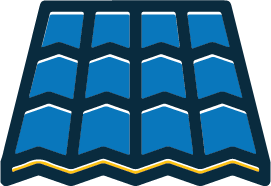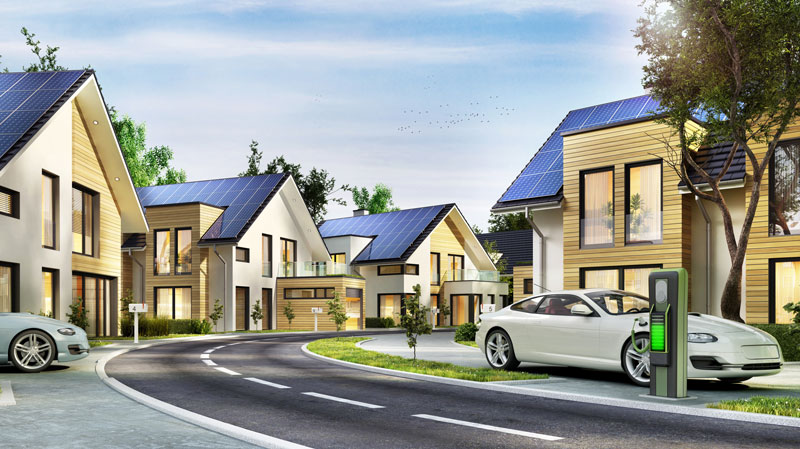There is no doubt that solar energy is the way of the future. As we look to move away from non-renewable energy sources, it’s more important than ever to find ways to supply power in a way that doesn’t harm the environment. Solar energy is an elegant solution, particularly for the needs of everyday homeowners. As solar panels become increasingly more ubiquitous throughout California, you might be asking yourself, “is my house good for solar panels?”, and whether or not it’s time to make the switch.
Many homeowners are deterred by solar because they don’t have all the information, and they may even be deterred by common myths and misconceptions. But solar isn’t complicated, and we’re here to help. There are many factors to consider if you’re interested in solar, and chief among them is the viability of your home. Some homes are better equipped than others for solar power. Do you want to know where your home stands and whether or not your house is a good candidate for solar? Consider the following questions:
WHAT AM I SPENDING EVERY MONTH ON POWER?

Spoiler alert — for the overwhelming majority of homeowners, the answer will be yes. But, let’s take a look at the nuances.
Solar energy saves you money in two ways. In the short term, it can replace your monthly electricity bill with a cheaper cost that stays consistent over the years and doesn’t inflate. In the long term, after your system is completely paid off, you’ll be paying virtually nothing for power each month. The former savings happen immediately, and the latter after 10-20 years, depending on your payment plan.
The cost of a solar power system depends a lot on the size of the system, how much power you use, and so on. But as a very general estimate, we recommend solar energy for people who spend at least an average of $75 a month on power. At this point, a solar payment system can reduce or even outright replace your monthly energy bill. If you live in a tiny home and you’re barely spending much on power, you might not need solar energy in the first place — unless you’re interested in the green initiative.
WHAT’S THE AVERAGE WEATHER LIKE?

You don’t have to worry about this in California, but snow isn’t ideal for solar, because the more of it that accumulates on the panels, the less sunlight they’re able to absorb. At a certain point, the panels won’t really be able to get anything at all.
So we can say “snow” worries, but then there’s the matter of hailstorms. Sunlight and UV rays can penetrate clouds, so it’s not the storm cover that’s the problem, it’s the hail itself. If the hail is big and comes down hard enough, it could potentially damage solar panels, in the same way that it damages roofs and cars. Solar panels are extremely hardy and they’re engineered to withstand the elements, but you should know going in that hail damage isn’t an impossibility. We’ve seen many solar arrays outlast the roof they sit on all over the country, even in hard-hitting hail zones like Colorado, but Mother Nature can be unpredictable.
Those are the two biggest climate-related issues. But again, if you’re in California, consider yourself lucky — you’re already in one of the best states possible for dependable solar coverage.
DO I LIVE IN THE SHADE?
One common myth about solar is that cloud cover prevents it from working. This is no longer true thanks to modern technology, but shade is another story. Shade is quite literally the absence of sunlight, so you’re not going to have much luck if your house is constantly covered by it.
We’re talking about shade that’s caused by objects that are directly blocking the sun. Some issues are solvable. You can, for example, cut down a massive tree that constantly obscures your home. But if you’re situated next to tall buildings that conveniently block the sun in most directions during most of the day, or if there’s a huge mountain or cliffs right behind your house, there’s not much you can do.
If your house is in a shady spot, we urge you to consult with the professionals before you make a decision. Sunlight and shade doesn’t seem complicated, but how much sun actually hits your roof in a beneficial way is trickier to gauge. You shouldn’t assume that solar panels are out of the question, but it will likely require some out-of-the-box thinking on the part of your solar installation company. But don’t worry, here at Energy Service Partners, we’re up to the task.
HOW IS MY ROOF SLOPED?

The slope of your roof matters because it affects the direction in which your solar panels are oriented. The more directly they’re facing the primary path of the sun, the more use you’ll get out of them. And since the sun moves around throughout the day, and changes position in the sky throughout the year, you want your solar panels angled in such a position to where they capture as much sunlight as possible regardless of the angle of the sun.
Again, this can get pretty complex, but consider the following as a super simple example. If you live somewhere with tall mountains to the west, you’ll get slightly less east-facing sunlight in the evenings because they will set behind the mountains. If you have an asymmetric roof that primarily slopes towards those mountains, this puts your home at a slight disadvantage for solar panels because they would theoretically be angled in the direction that receives comparatively less sunlight throughout the day.
In most scenarios, roof sloping isn’t a dealbreaker, and it can often be abated through clever installation techniques — but it is one factor out of many. The more you know!
IS MY ROOF IN GOOD CONDITION?
Your solar panel system is installed on your roof, and it’s not exactly lightweight. Solar panels are heavy pieces of equipment, and they’re meant to be there for the long haul. In a way, this is good news for your roof — the solar panels will end up taking much of the abuse that it would normally receive from sun and weather. But if the roof is in poor condition from the start, you might want to take action before you order solar.
A good roof can last anywhere between 20-50 years, so this is mainly a problem for older homes. But if your roof is indeed in a sorry state, your house may not be a great candidate for solar. Consider repairing or replacing it before you get solar installed. While it is possible to remove the solar panels, repair a roof, and put them back on, it will require the work of professionals, it will temporarily disrupt your solar energy, and it’s just a major inconvenience overall. By repairing your roof before you install the solar panels, you can have the peace-of-mind knowing that you won’t have to worry about it for the foreseeable future.
CALIFORNIA’S LEADING SOLAR INSTALLATION COMPANY
If you’re a California homeowner looking to install solar, we encourage you to contact us today. While the aforementioned points are key factors in determining how good a home is for solar panels, that’s ultimately something you should leave to the professionals. At Energy Service Partners, we provide industry-leading installation times and incredible support afterwards. If you’re in California, there’s no better solar company in the industry.
Are you ready to make the transition to renewable energy? Are you ready to start saving money on your monthly energy bills? Contact Energy Service Partners to get started.
